If you’ve ventured into a restaurant, bar, office building, or shopping district recently, you’ve likely come across a living wall. Also called vertical gardens, green walls, and plant walls, these installations are not only aesthetically pleasing, but provide a host of other benefits. But first thing’s first … most people just want to know how you do it!
How they work
“People are fascinated with how they work and the designs we are able to put on these walls,” said Leslie Herndon, VP of Operations at Greenscape in Holly Springs, which has installed and maintains several living walls in Raleigh’s Village District. “Our walls at the Village District require quite a bit of maintenance, as they are outside and designed to be changed out frequently. We water them in the summer almost daily, and they are heavily pruned due to the aesthetic we are looking for. We treat these as living art.”

City Garden Design installed this moss wall at the offices of Ovesco in Cary.
Interior living walls that are more permanent are watered less frequently due to the reduced heat of the environment. However, they all need to be scouted for insects and diseases and fertilized frequently. Irrigation systems, which are installed behind the plants, also need to be monitored regularly, as the slightest issue can create problems with plant life.
While Herndon has installed an entire edible wall for Village District in the past — complete with mini tomatoes and herbs — they stick to mostly annual flowers in the summer. Currently they have lantana, coleus, scaevola, salvia, firetails, and many more. In the winter, it will change to pansies, violas, heuchera, and ivy.
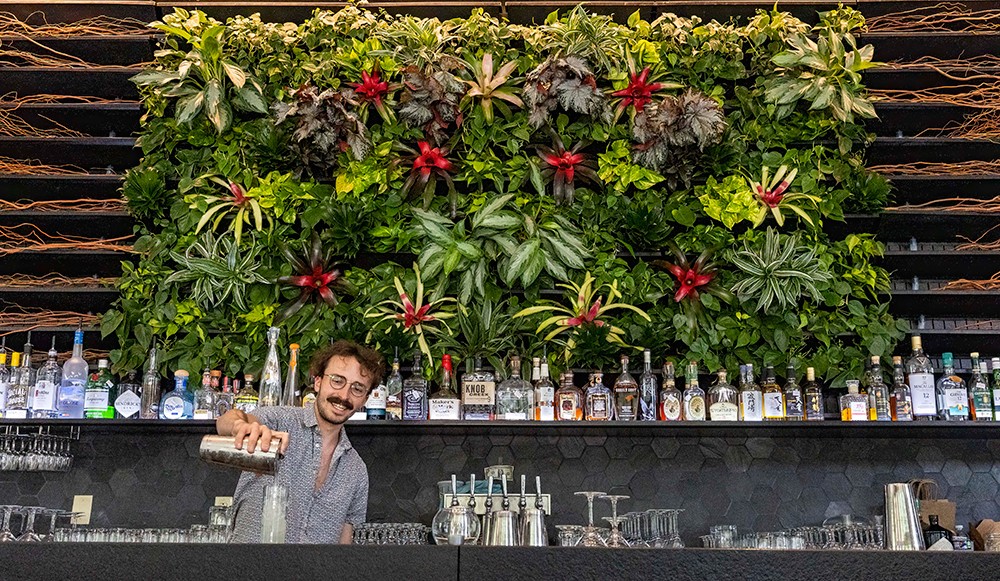
Jarrod Homan pours a cocktail in front of the living wall at ko- •än.
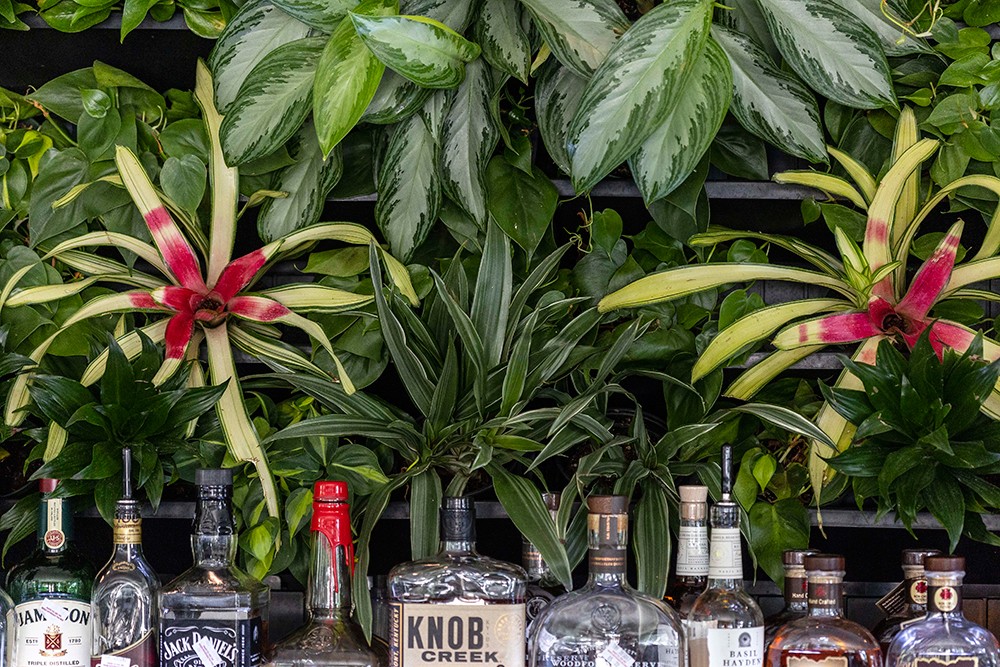
ko- •än’s living wall is cared for once a week.
Sarah Marks of Atlantic Designscapes, which designed and maintains a living wall in the bar area of Cary’s kō•än restaurant, adds that indoor environments require just as much technical care as they do creativity. “The design changes with plants periodically and through the seasons. Also, plant care is much more than watering,” said Marks. “That environment goes through changes along with our regular seasons. Heating and air conditioning shifts the needs of a green wall, as well. It is made up of many smaller trays, so that allows us to use plants with different water needs.”
The wall at kō•än, filled with dracaena, pothos, philodendron, and bromeliad, is cared for once a week.
Benefits
“You get the opportunity to green up gray spaces, which provides environmental and aesthetic benefits,” said Herndon. “We also want to encourage people to get outside and create enjoyable spaces for them to be in. Go have your photo taken at one of the many walls in the Village District, including a double-sided one you can put your face in the middle of for the photo opp.”
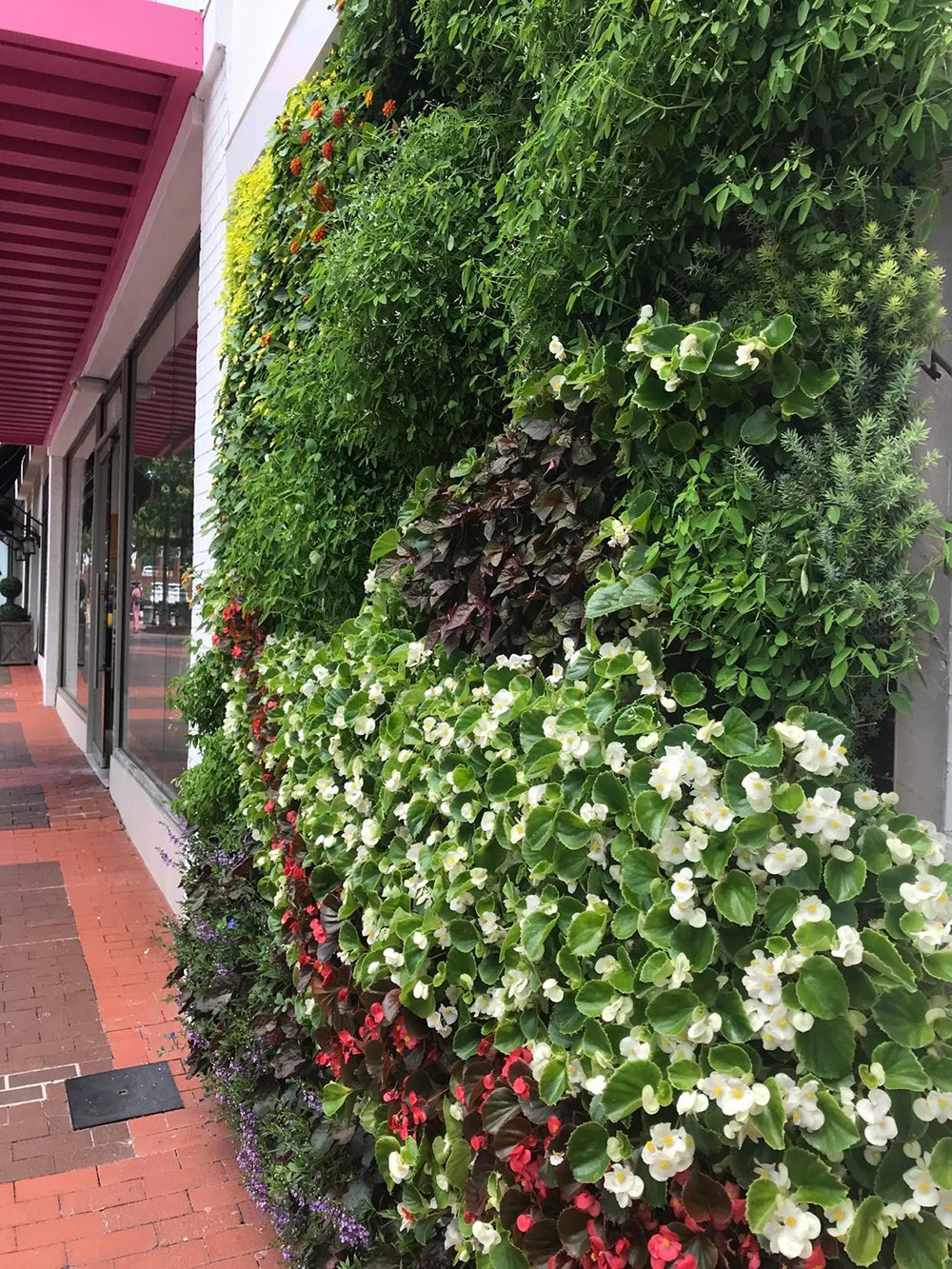
A living wall in Raleigh’s Village District was installed and is cared for by Greenscape out of Holly Springs. Contributed photo.
Inside, they are good at providing clean air, noise reduction, and simply creating something beautiful to admire. At Bond Brothers Eastside, their 12-foot by 12-foot living wall greets you on the right just after passing through the door. Installed in 2021 with the help of Cary’s Garden Supply Company, this wall boasts ferns; several varieties of pothos; pink, neon, and white butterfly Syngonium; Hypoestes (polka dot plant); and nerve plants.
“They supplied the plants, and my brother and I made and installed it,” said co-owner Jay Bond. “We initially planned on making it at our other location, so I did research probably over six years ago and had the design in my head. But it wasn’t until we opened here that we realized this is just a perfect spot for it.”
Bond and his brother Jeremy made the drip irrigation system themselves. They also do all the maintenance. “You have to maintain it just like a house,” said Bond. Every once in a while, I walk up and just take off some dead pieces or, as things grow bigger, I take cuttings off and I propagate them in little glass jars. When they root, I put them back in the wall.”
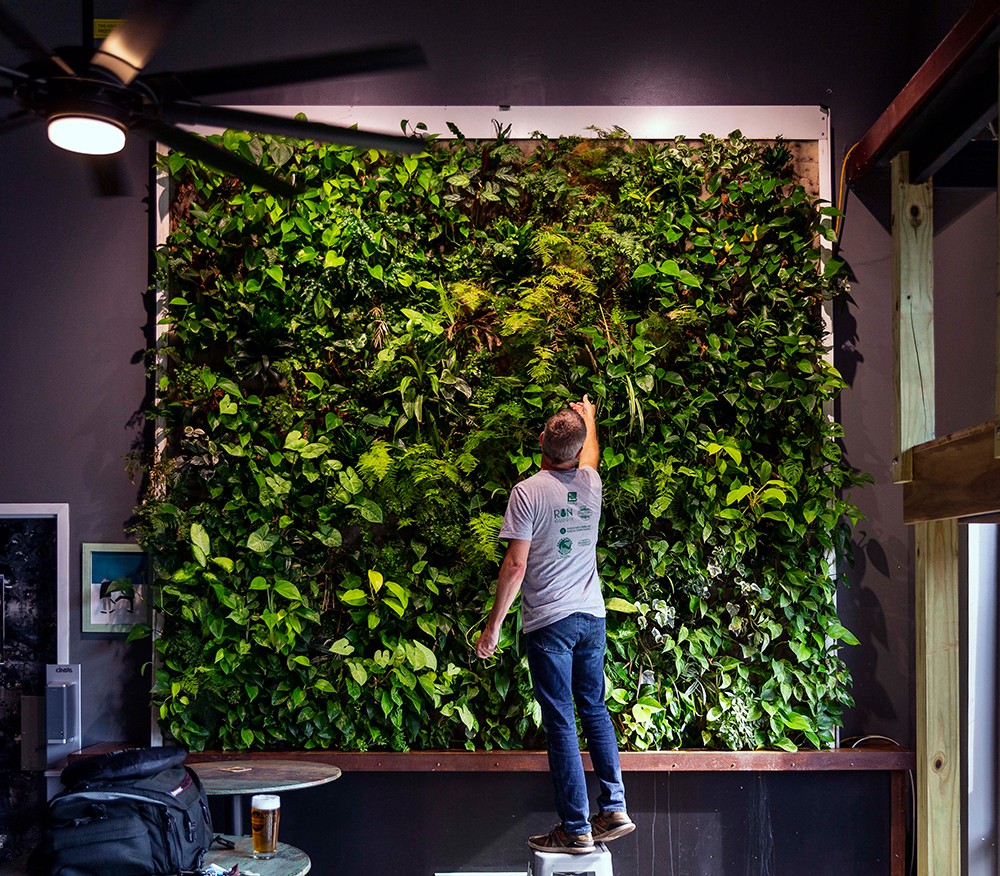
Jay Bond enjoys working on the living wall at Bond Brothers Eastside, which he installed and maintains with his brother, Jeremy. The plants were supplied by Garden Supply Company.

They also installed three grow lights overhead that are on a schedule to give the plants light during the night. “They come on until the morning, so they’re pretty much getting sunlight all the time,” said Bond.
Caring for the wall comes naturally to Bond. “I was in horticulture with a small company that grew herbs and flowers years before I started working in the beer industry,” he said. “I have always loved plants, and it was on my bucket list to do something where I can come in and play with it, look at it, watch it grow, and take care of it.”
A living wall was the plan for kō•än from the very beginning, when they opened in 2019. “The concept for the restaurant was to make it open, airy, and fresh, and that’s where all the plants and the plant wall come into play,” said manager Brandy Ray. “The customers love it. They take pictures in front of it, and are always asking if it’s real because they can’t believe we have such a big wall that is watered and maintained.”
Where to begin
Shannon Theis with Garden Supply Company suggests an easy way to get the look and feel of a living garden at home. “While we do not offer installation of living walls, we do feature picture frame planters to create a small living wall space,” she said. The planters come is three sizes up to 8 inches by 10 inches. They lay flat for watering, then get hung back up. There is a drip reservoir for the remaining water.
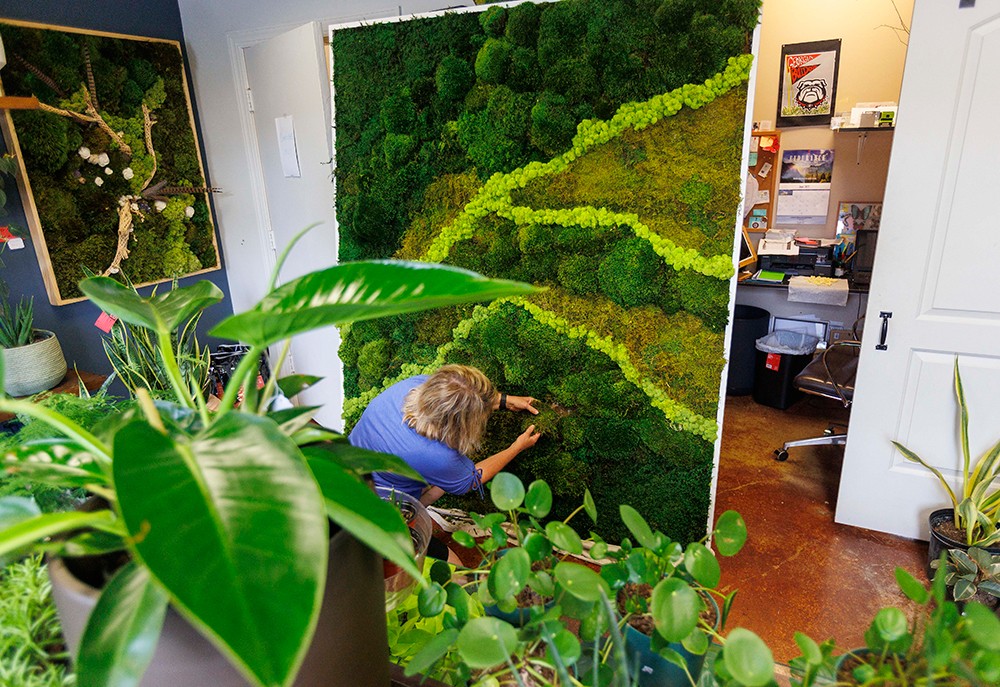
Paula Higdon of City Garden Design works on a moss wall in their Cary store.
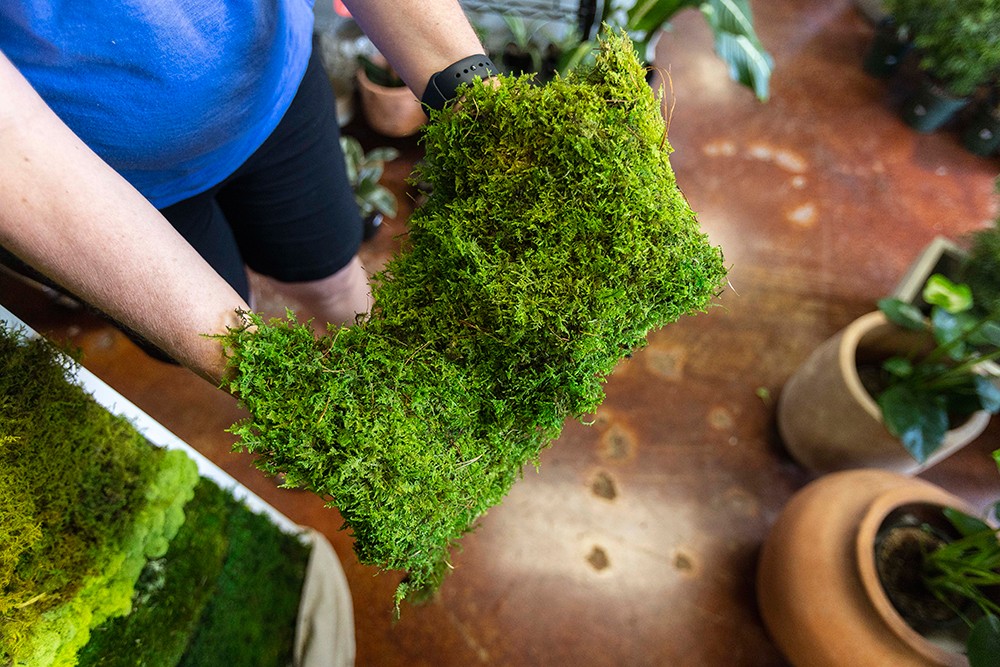
Preserved moss is easy to maintain because it requires no light or water.
There are also plenty of DIY opportunities that homeowners can explore via YouTube or Pinterest, said Herndon. “Anything from reusing pallets, to gutters, to prefab panels off Amazon, or reused plastic bottles. You are only limited by your imagination and budget,” she said. “Some important things to consider are the type of plants, sun exposure, drainage, and ability to water. Also, what type of structure are they going onto, and do you need to protect the wall from water damage in any way?”
Starting simple with a little help is always a good approach, said Herndon. “I always recommend starting with a regular container garden first. Work with a local garden center to pick plants out that fit your environment and time commitment,” she said. “Once you get the hang of that, then you can explore the world of living walls. Think of living walls as the advanced stage of container gardening.”
Go Maintenance-Free with Moss!
Moss walls are a great way to bring nature into your home, but without the all the upkeep of a living wall. We chatted with Paula Higdon, owner and buyer for Cary’s City Garden Design, to learn more about this trend.
How does a moss wall differ from a living wall?
The moss is preserved, so it’s no longer living. Unlike living walls, moss walls do not require any light or water. A lot of people assume that moss walls need to be misted for moisture, but there really is zero maintenance required. Much like a potted plant, living walls need regular maintenance like irrigation, light, and sometimes pest control. For the most part, moss walls are one and done.
What kind of moss is used, and how is it preserved?
There are lots of options: mood, sheet, reindeer, shag, and Spanish moss. The moss is preserved with a plant-based glycerin and natural dyes. The glycerin is used to keep the moss fresh and moist looking, and the dye is used for long-lasting color. There are many shades of greens and color options. A lot of the moss we use comes from the mountains of North Carolina and Kentucky.
How do you make a moss wall last?
The moss will last for years. Since it’s dyed, it’s best used inside away from the elements such as rain and direct sun. Avoid using it in really arid areas and around fireplaces.
Is there unlimited potential as far as design goes?
Moss walls offer a lot of room for creativity and personalization. They can be simple and offer a more natural, organic look or be bold and abstract like a piece of modern art. For a more natural look, we’ll incorporate pieces of driftwood, preserved ferns, lichen, or mushrooms. Or for something fun, we’ll use geodes, crystals, and feathers.
Why have these become so popular?
Moss walls are a great way to add greenery and bring nature indoors without any maintenance. They can be used in almost any setting as a fun and interesting way to express creativity. Pinterest and social media sites such as Instagram and Facebook are a great way to see how people are using moss. The possibilities seem to be endless.
What are the benefits?
Studies have shown biophilic interiors, such as moss walls, can help reduce stress and anxiety. Moss walls are created using sustainable, natural materials and allow us to feel more connected with nature while indoors at either home or work.
- Local Celebrity Pets
- Living Walls
- Building the Dream
- House It Going in the Real Estate Market? A Realtor Q&A
- Susu Hauser: The Woman Behind the Camera
- Erica Chats: Explore Family Fun
- Small Business Spotlight: AR Workshop Cary
- Nonprofit Spotlight: AnimalKind
- Restaurant Profile: TapStation
- Liquid Assets: The Ruby Leaf
- Liquid Assets: Kölsch from White Street Brewing Company
- On Trend: The Wonderful World of Wallpaper
- Garden Adventurer: Strange Beauty: Turtleheads
- Things to Do: August 2022





